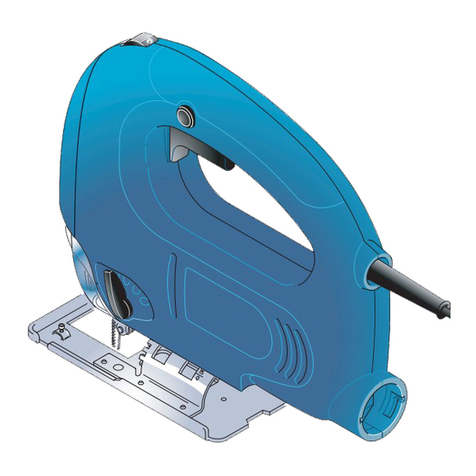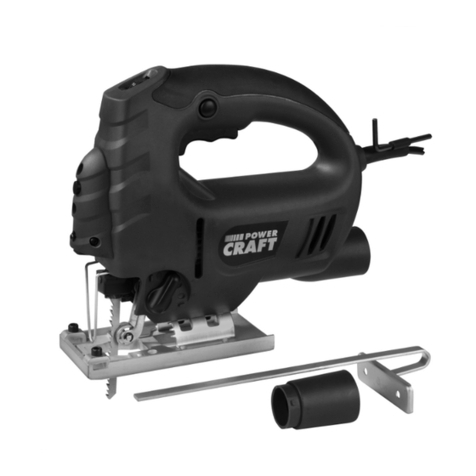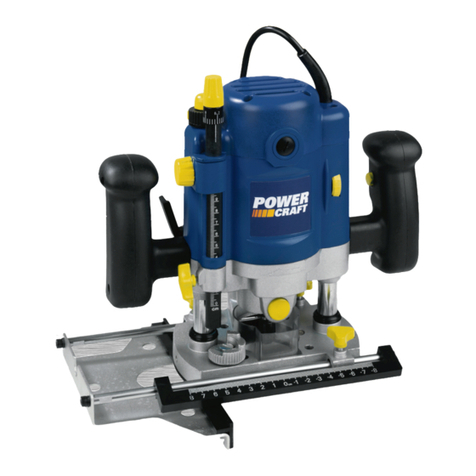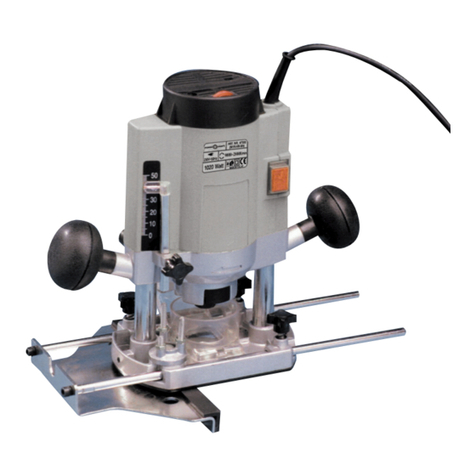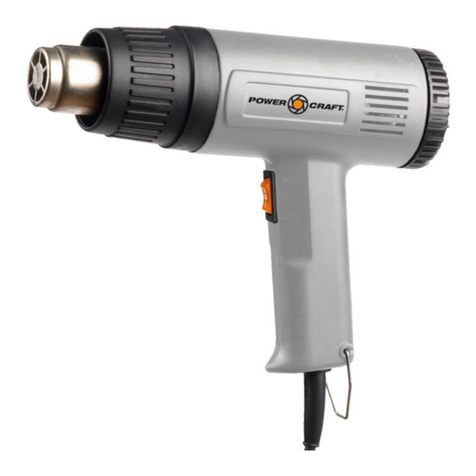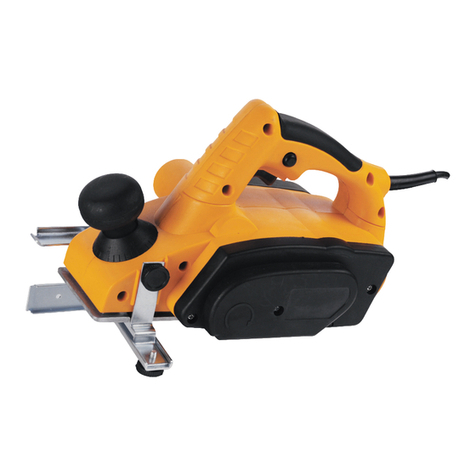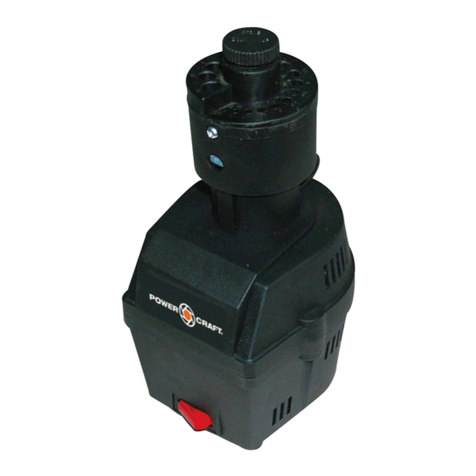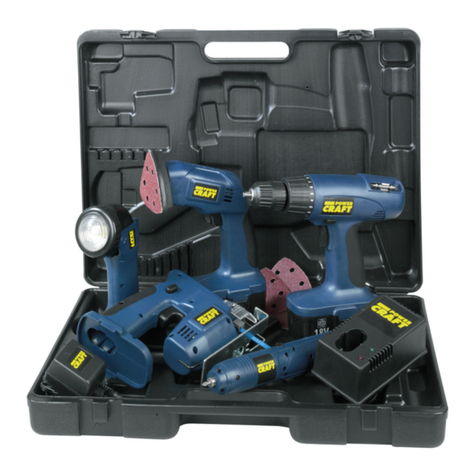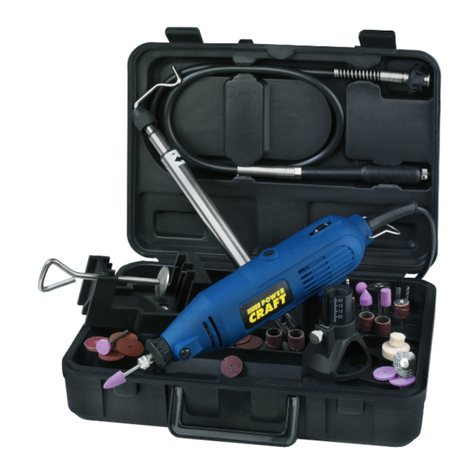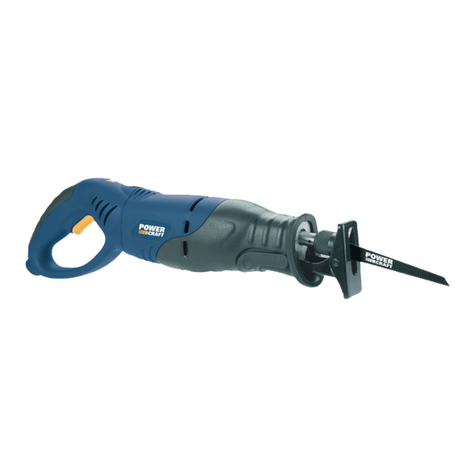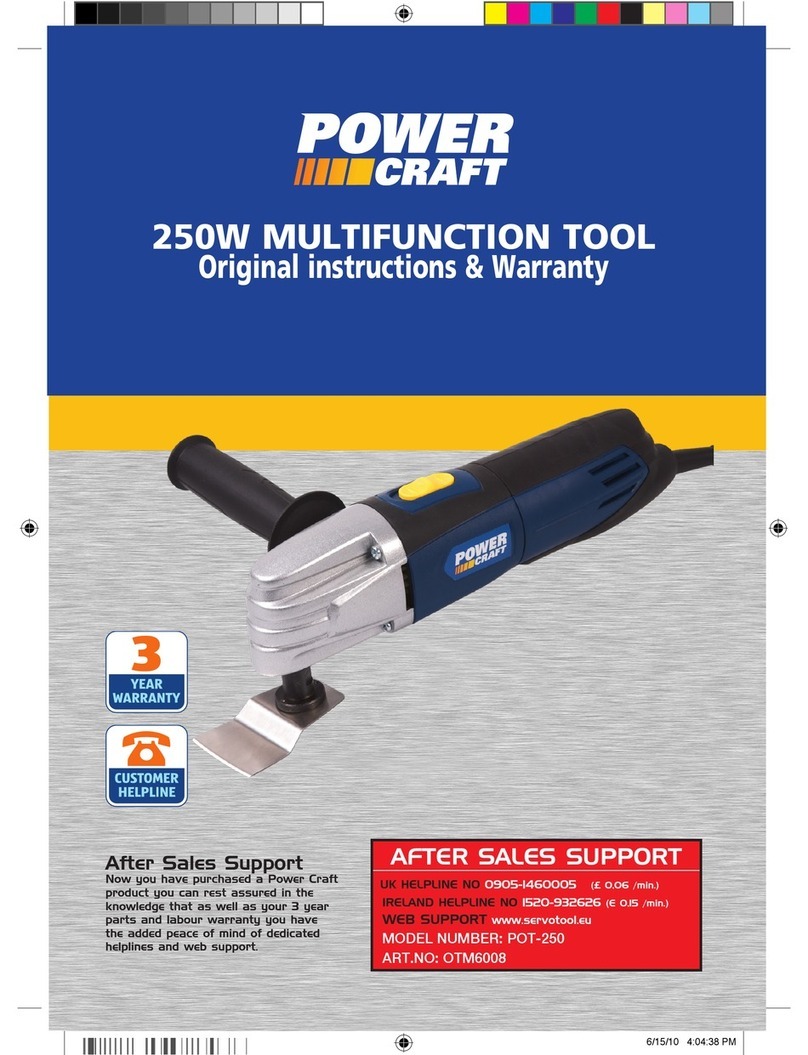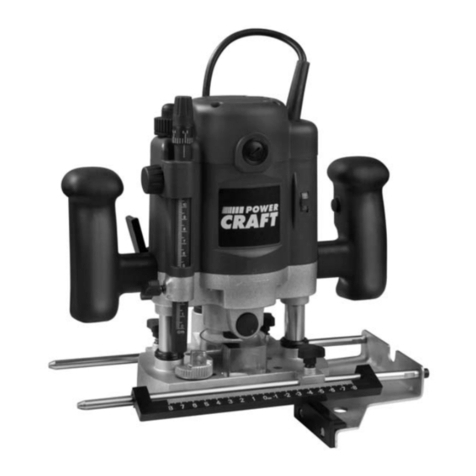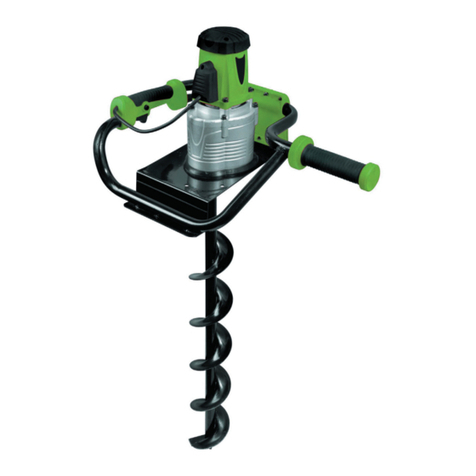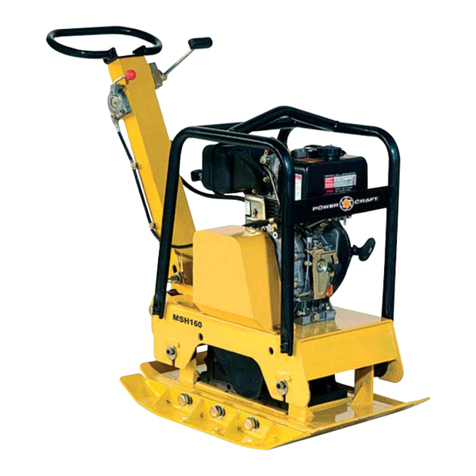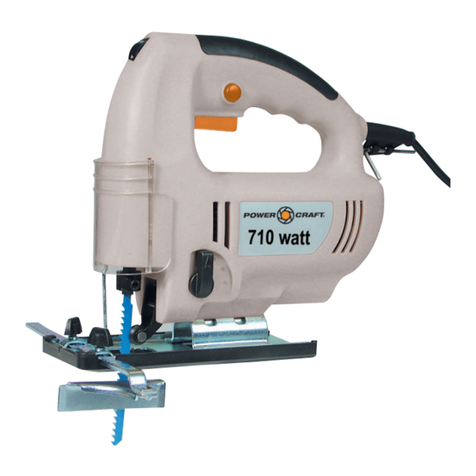USING THE SAW
GENERAL INSTRUCTIONS
Figs. 3.1-3.6
Fig. 3.1 The material to be sawn must not be thicker than
the maximum saw depth.
Fig. 3.2 Before use, check the saw blade for damage and
replace it if necessary.
Fig. 3.3 Make sure that the piece of work to be sawn is
well clamped down.
Fig. 3.4 Make sure that the piece of work to be sawn is
clean.
Fig. 3.5 Make sure that there is enough space below the
piece of work to be sawn, so that the saw does not come
into contact with other surfaces.
Fig. 3.6 Make sure that the material to be sawn is free of
nails and screws and the like.
INSTALLING THE SAW BLADE
Figs. 2 and 4.1-4.4
Make sure that the power cord is not plugged into
the mains.
To install the saw blade, loosen the Allen screw (A) using
the Allen key (C) (by turning it anticlockwise). Place the
saw blade (B) in the blade holder from underneath with
the saw teeth pointing forwards. Tighten the Allen screw
(A) using the Allen key (C) (by turning it clockwise).
Check that the saw blade is installed at right angles to the
base plate (see Fig.4.4).
ADJUSTING THE BASE PLATE
Figs. 2 and 5.1-5.5
Make sure that the power cord is not plugged into
the mains.
To install the base plate (D) the Allen screws (E) must be
unscrewed (anticlockwise). The base plate (D) can now
be moved backwards. Now the saw angle required can
be set, which can be read (F). After setting the correct
angle the base plate (D) must be moved forwards again
into the interlocking position. Then the Allen screw (E) is
screwed tight again.
For saw angles that are different from the standard
adjustable angles, the base plate does not have to be
moved forward again into the locking position. After
setting the correct angle, make sure that the Allen
screws (E) are screwed tight.
USE OF THE PARALLEL GUIDE
Figs. 6.1-6.4
Make sure that the power cord is not plugged into
the mains.
The parallel guide (H) can be mounted as an aid to sawing
a straight strip of wood, for example.
Unscrew the Allen screws (G) (anticlockwise). Now the
parallel guide can be set in the base plate to the distance
required. See the calibration marks on the parallel guide.
Finally tighten the Allen screws (G) (clockwise) using the
Allen key (C).
REGULATING THE PENDULUM ACTION
Fig. 7
For hard materials always choose a low pendulum
action.
Installation hints – choice of saw blade
Saw blade Type of material
Rough Wood
Medium Wood
Fine Plastics, aluminium, steel
Very fine Sawing curves (wood)
Pendulum action* Accuracy
2, 4, 6 +
2, 4 ++
2 +++
2 +++
*Continuously variable
SETTING THE PENDULUM ACTION
Fig. 3
To get the optimum result when sawing, you must set up
how the teeth of the saw blade must cut into the
material. You do this by adjusting the pendulum action.
•Soft material (wood, plastics, etc.): choose pendulum
action II or III. For sawing shiny materials choose
pendulum action 0 or I.
•Medium hard materials (hardwood, aluminium, etc.):
choose the pendulum action you need. For thin
materials use pendulum action 0 or 1 if you work
with rasps or knives.
•Hard materials (steel etc.): choose pendulum action 0.
•Curved saw-cut: choose pendulum action 0.
The pendulum action can be chosen while the jigsaw is
turned on.
OPERATING
Figs. 8.1-8.2
Switch 1 turns the machine on. In addition, for longer
saw-cuts the button 2 can be used: this locks switch 1 in
the ON position. To switch the machine off, press
button 2 again.
ADJUSTING THE STROKE RATE
Fig. 9
The stroke rate required can be set with the aid of the
revolution regulator (I).
Powercraft 9
•Never use the equipment where it could cause a fire
or an explosion. Keep it out of the neighbourhood of
flammable liquids and gases, as electric equipment
can cause sparks that can lead to a fire.
• Keep children and other people away when using the
equipment. If you become diverted you can lose
control of the equipment.
2. Electrical safety
• The plug on the power cord must fit perfectly into
the wall socket. The plug must never be changed in
any way. Do not plug the tool into any socket
adapters. Unchanged plugs and suitable sockets
reduce the risk of electric shock.
• Avoid bodily contact with earthed surfaces such as
metal pipes, conduits, central heating pipes and
radiators and refrigerators. The risk of an electric
shock is higher when your body is earthed.
• Never expose the equipment to rain or damp.
Water penetration into electric equipment
increases the risk of electric shocks.
• Never use the power cord to lift the equipment or to
hang it up, or to pull the plug out of the socket. Make
sure that the power cord does not lie on or come
into contact with and keep it away from heat, oil and
all moving parts. Damaged and tangled power cords
increase the risk of an electric shock.
• When you use the equipment in the open air, only
use an extension cable that is approved for outside
use: in this way you reduce the risk of an electric
shock.
3. Personal safety
• Be attentive, pay attention to what you are doing and
use your common sense when working with this
equipment. Never use tools when you have been
drinking alcohol or taken medicines. One moment of
inattention can lead to serious injury.
• When using this machine always wear safety
equipment and safety glasses. Depending on the
circumstances you can also lessen the risk of
accidents by wearing a facemask, sturdy work shoes
with non-slip soles, a safety helmet and ear
protection.
• Prevent the machine being switched on by mistake:
always check that the ON/OFF switch is in the OFF
position before plugging the equipment into the
mains socket. If you carry the machine with your
finger on the ON/OFF switch or connect it to the
mains when the switch is in the ON position, this can
result in accidents.
• Remove all tools and screw keys used for setting up
or adjusting the machine before you switch on the
equipment. A tool or key that comes into contact
with a rotating part can cause accidents.
• Do not overestimate yourself. Make sure that you
stand firmly and that you keep your balance at all
times. In this way you can keep the equipment under
control in unexpected situations.
• Wear suitable clothing. Do not wear loose clothing
or jewellery. Keep your hair, clothes and gloves away
from moving parts. Loose clothing, jewellery and
long hair can become trapped by moving parts.
• When a dust suction and dust catching installation
are installed, check that these are connected and
used in the right way. Use of these installations leads
to less inconvenience caused by dust.
4. Handle and use electrical tools carefully.
• Make sure that the equipment is not overloaded and
use it only for work for which it is intended. Keep
within the stated performance limits.
• Never use electric equipment that has a defective
switch. Electric tools that can no longer be switched
on and off are dangerous and must be repaired.
• Unplug the equipment from the mains before you
adjust it, install accessories or put it aside. In this way
you can prevent the machine being started
accidentally.
• Keep electric equipment that is not in use out of the
reach of children. Never allow the equipment to be
used by people who are not familiar with it or who
have not read the instructions for use. Electric
equipment can be dangerous in the hands of
inexperienced people.
• Make sure that the equipment is well maintained.
Regularly check that all moving parts move freely and
do not stick, and check for any broken or damaged
parts that can prevent the equipment working
properly. Have any damaged parts repaired before
using the equipment again. Many accidents are
caused by insufficient maintenance of electrical
equipment.
• Make sure that the saw blades are sharp and clean.
Well-maintained saws with sharp edges stick less and
are easier to guide.
• Always use electrical equipment according to the
hints and directions for use for the equipment
concerned. Take into account the circumstances and
the task to be carried out. Use of electrical
equipment for other purposes than those it is meant
for can lead to dangerous situations.
5. Maintenance and repairs
• Only have this equipment repaired by skilled
personnel using original parts. In this way you can be
sure that the safety of the equipment is guaranteed.
• If the power cord needs to be replaced, have this
done by the manufacturer or a recognised
representative. In this way you can be sure that the
safety of the equipment is guaranteed.
USES
With this jigsaw you can saw pieces of various materials
(wood, aluminium, plastics, metal, etc.) very accurately
and into any form. The maximum thickness of the
material to be sawn is 70mm (for wood).
All other applications (such as stationary use, for
example) are expressly forbidden.
The maximum saw depth of 70mm is only possible with
an extra long saw blade.
For hard materials always choose a small orbital
movement.
8Powercraft
